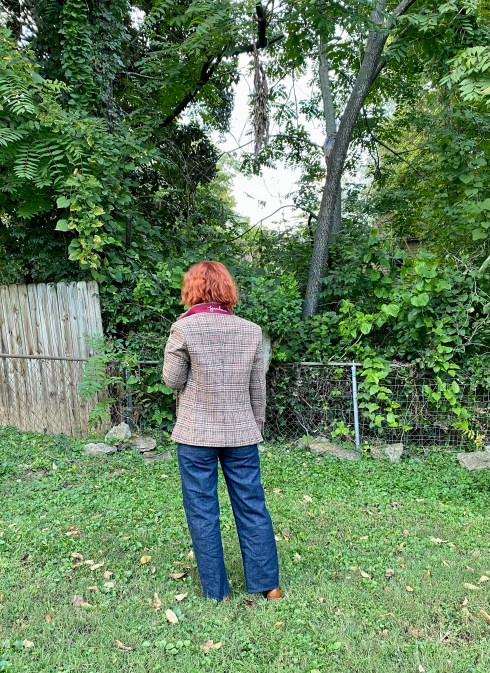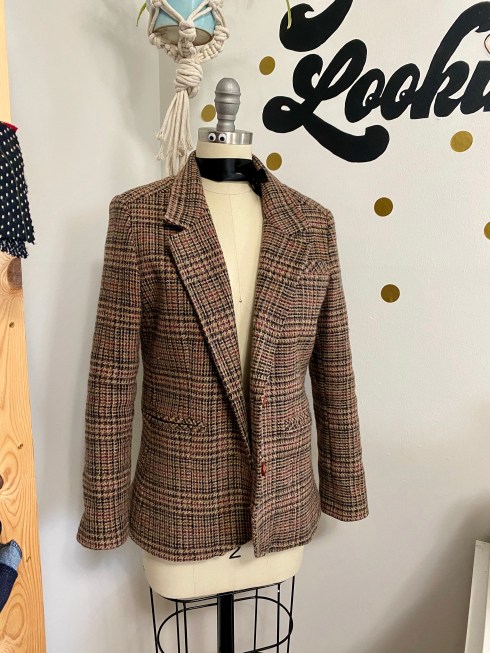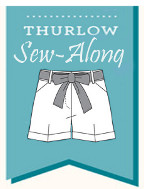Here’s a big ol’ project I worked on for a couple months this summer that I believe warrants a whole ass blog post!

Fair warning – there are a LOT of photos in this post. I tried to narrow them down and include some collages, but… don’t say I didn’t warn you!
This project started with me wanting to make a blazer – but after months of looking and just not feeling any of the fabrics I was seeing, I decided I would try altering one instead. I’ve altered plenty of blazers, jackets, and coats for lots of clients + photoshoots over the years, but I’ve yet to really tackle complicated alterations beyond sleeve shortening and taking in the body (since, understandably, most people don’t need those kind of crazy alterations!). Over the summer, I worked closely on a photoshoot set with a master tailor here in Nashville, Loretta, who was delighted to share a lot of her trips and tricks with me. I spent some time looking for the perfect blazer for this project, and eventually found this 70s gem at the Southern Thrift in West Nashville, for a grand $5.99-

As you can see, the before wasn’t super terrible! Obviously the sleeves were a little long and the back a bit saggy (there was no size tag in this jacket but I suspect it was probably 1-2 sizes too big for me). I also felt like the shoulders were a touch wide, and the length a little too long. But I loved the fabric and knew I could work some magic to get this bad boy to fit the way I liked!
I started with pulling off the buttons, the back belt, the cheesy patch pockets (I’m sorry, but they are SO cheesy lol and were also poorly sewn on!). I removed the entire lining from the shell and set about my alterations first. Here is what I ended up doing:
- Narrowed the shoulders by 1/2″
- Added shoulder pads (the original ones had disintegrated into the jacket hem! I am STILL finding old shoulder pad dust in my studio, despite regular vacuuming!)
- Took in back arm seams 3/8″
- Took in side back seams 1/8″
- Took in center back seam 1/2″
- Shortened body length 2″
- Shortened sleeve length 3/4″
This was accomplished by lots of pinning, basting, trying on, and taking photos (so I could see what the back looked like). Usually when I do these alterations, I work with a client who is already wearing the jacket – so it’s quick and easy to pin where needed. It’s a little harder when you are doing it yourself, but still totally doable!

After finishing the alterations, I could work on the fun stuff – adding design elements to the shell! I knew I wanted to change those patch pockets out for double welt pockets. I also wanted to include sleeve vents with functioning (!!!) button holes, a single welt breast pocket, and an interior “Barcelona” pocket.
Since I had removed the patch pockets and back belt from the original jacket, I was able to carefully disassemble them which gave me some fairly good-sized pieces of fabric to work with. Adding the double and single welt pockets was pretty straightforward and easy – it’s the exact same as sewing on a piece of fabric, you just have to contend with, well, an entire jacket getting in your way haha. I used the instructions + pattern pieces from the Closet Core Patterns Jasika Blazer for the two exterior pockets, and a beloved In-House Patterns tutorial for the inner pocket. Honestly, the hardest part about this endeavor was figuring out where exactly to put the pocket! For the outside pockets, I drew chalk lines directly on the blazer and checked the proportions in the mirror until I was happy. For the interior pocket, I went a little lower than my chest after looking at loads and loads and LOADS of blazers online with interior pockets – consensus seems to be that it starts right below the welt of the outer breast pocket. Which makes sense, as you don’t want whatever you put in that pocket to sit right on top of your breast. Well, I don’t want that anyway haha.
For the sleeve placket – well, that was a fun experience! The original jacket had no placket – just buttons sewn straight on a plain sleeve. Loretta had shown me how to shorten a jacket sleeve with a working button placket, which is the same process as adding a placket. You just sew fabric to the edge to create a placket extension; all the seams are hidden when it is finished. I had no idea shit would be that simple. I think the scraps I used came from the back belt. For a step by step, I followed these directions for sewing a back vent (a back vent and button placket on a jacket are essentially the same – except there is no exposed line of diagonal stitching) from Waffle Patterns. The hardest part of that was getting the corners to miter correctly haha. Wish I could give y’all some tips for that but TBH I just used a lot of trial and error and unpicking until it was right.

I also decided to change out the lining, after determining the original lining – while a really beautiful soft pinkish beige – was just too smelly and discolored. I took the lining apart and used the pieces to cut a new lining from a piece of silk charmeuse that I already had in my stash (here is a blog post I wrote a few years ago about replacing a lining in a coat, which is the same process I used!). I made sure to add my alteration adjustments and sleeve plackets to the pieces, then sewed the whole thing together and bagged it in. I did hand sew at the sleeve button plackets and near the front facing (you can sort of see the pins in the above photos), but the rest was done by machine.

After THAT was done (whew!), I added some fun finishing touches 🙂 I sewed buttons + button holes on the sleeve plackets (using the original buttons, cos, well, I like them!), added a leather hanging tab + label to the back facing – oh, and I made a sweet wool felt embroidered undercollar!

To make the undercollar piece, I cut some Swedish tracing paper and traced it around the undercollar, trimming and refining until it was the exact same size. Then I cut it from wool felt (which I ordered the The Felt Pod); my piece was wider than the felt so there is a seam in the center. Then I embroidered it by hand with a simple chain stitch, and attached it directly over the existing undercollar using embroidery floss + a blanket stitch. It’s not visible when the collar is down, but it is a fun surprise when flipped up!
I actually finished the whole thing about a month or so ago, but didn’t get around to taking photos until this last weekend. I’ve said it before, and I’ll say it again – taking photos is the part I hate most! So, like, enjoy or something 😛 I’m pretty sure my neighbors did considering that came outside RIGHT WHILE I WAS SHOOTING THESE dear lord can you see the fear in my eyes?




And if you don’t want to look at my mug (it’s cool, I don’t want to look at it either), here are some dressform shots:



I think that’s about it for this project! I had a lot of fun digging into this one and feel extra confident in my alteration skills as a result. Funnily, the original jacket isn’t very fancy – it’s actually pretty cheaply made as far as jackets go. The wool is a blend, and there wasn’t much tailoring inside the shell apart from a bunch of interfacing. Spending so much time + effort (and silk lining lol) was basically the equivalent of polishing a turd – but, you know what? I love how it turned out, and I learned a lot during the process. I don’t know if such an involved reconstruction would be worth it if you were paying someone else to do it – but for me and my sewing practice? It was perfect. I was only out about $10 for this project (the jacket + wool felt, as I already had the lining in my stash) which we can all agree is WAY cheaper (and faster!) than making the dang thing from scratch!

I will always love making garments from their humble fabric beginnings, but truly, you can’t beat a solid reconstruction (or even just a couple simple alterations to an otherwise great + previously-loved garment!). This might be the most sustainable I get when it comes to sewing, ha! How about you? Does this inspire you to give it a try?































































































































































































